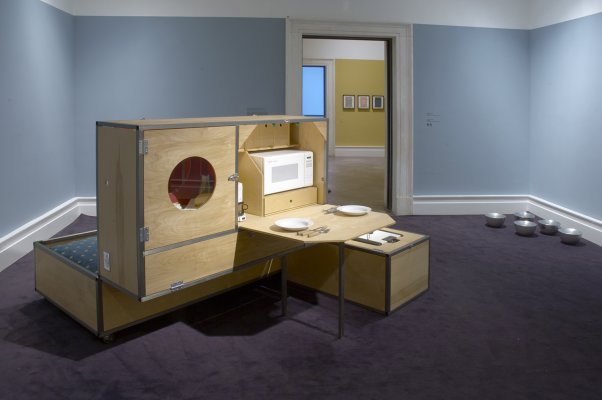Andrea Zittel: Critical Space
Friday, October 6, 2006–Sunday, January 7, 2007

Installation view of Andrea Zittel: Critical Space (–). Photograph by Tom Loonan.
1905 Building
Andrea Zittel is one of the most exciting and influential artists of our time because she makes art about the questions that nag us everyday: what to wear in the morning, what to fix again for dinner, how to deal with all the clutter, and how to escape the tyranny of the clock. Part philosopher, part scientist, part designer, part artist, Zittel has made her own life an experiment about the best way to live.
Zittel lives deliberately by paring down her life to the essential elements. She designs clothes to be worn every day for six months, devises diets of dehydrated food, and constructs multi-purpose furniture to meet her needs in an extremely limited space, all as a means of addressing the larger concerns of the human condition. A conceptual artist, Zittel has been influenced by a diverse list of artists, including Jenny Holzer, Dan Graham, Donald Judd, and Joseph Beuys, and by the constructivist and Bauhaus movements. Her work has, in turn, set an example for a younger generation of artists who make up their own rules and use their own lives as the basis for the production of their work.
Andrea Zittel: Critical Space was a mid-career survey, which gathered together more than 75 of Zittel’s works—habitats, installations, drawings, and documentation—created between 1991 and 2005. The Albright-Knox celebrated its commitment to contemporary art in all of its manifestations by presenting the work of this important conceptual artist in a way that encouraged audience participation.
This exhibition was organized by Associate Curator of Contemporary Art Claire Schneider.
Exhibition Sponsors
This exhibition was co-organized by the Contemporary Arts Museum Houston and the New Museum of Contemporary Art, New York. The exhibition is made possible by a grant from the National Endowment for the Arts, a Federal agency; the patrons, benefactors, and donors to the Contemporary Arts Museum Houston’s Major Exhibition Fund; and the Peter Norton Family Foundation. The accompanying catalogue has been made possible by a grant from The Brown Foundation, Inc. of Houston, with additional support from the Elizabeth Firestone Graham Foundation. The presentation of the exhibition in Buffalo is made possible by Judge and Mrs. John T. Elfvin, with additional funding from Sotheby’s, Cannon Design, and New Era Cap Company.
This exhibition was co-organized by the Contemporary Arts Museum Houston and the New Museum of Contemporary Art, New York. The exhibition is made possible by a grant from the National Endowment for the Arts, a Federal agency; the patrons, benefactors, and donors to the Contemporary Arts Museum Houston’s Major Exhibition Fund; and the Peter Norton Family Foundation. The accompanying catalogue has been made possible by a grant from The Brown Foundation, Inc. of Houston, with additional support from the Elizabeth Firestone Graham Foundation. The presentation of the exhibition in Buffalo is made possible by Judge and Mrs. John T. Elfvin, with additional funding from Sotheby’s, Cannon Design, and New Era Cap Company.